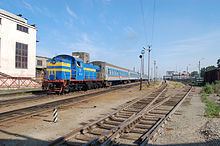Dates of operation 1992–2010 | Track gauge 1,067 mm (3 ft 6 in) | |
 | ||
Successor Far Eastern Railway (2010—present) | ||
Sakhalin railway
Sakhalin Railway (Russian: Сахалинская железная дорога) was a subsidiary of the Russian Railways from 1992 until 2010, when it was made part of the Far Eastern Railway.
Contents
- Sakhalin railway
- History
- Re gauging and potential connection to the mainland
- Potential connection to Hokkaido
- References
History
The Treaty of Portsmouth following the Russo-Japanese War of 1904-05 placed the northern half of Sakhalin under the control of the Russian Empire, whilst the southern half (Karafuto) was under control of Japan.
On the Japanese half of the island, a 42.5-kilometre (26.4 mi) long railway was built from Korsakov (大泊 (Otomari)) to Yuzhno-Sakhalinsk (豊原 (Toyohara)), with a gauge of 600 mm (1 ft 11 5⁄8 in). This section was later converted to the normal Japanese railway gauge of 1,067 mm (3 ft 6 in).
In 1911, a 53.9 km (33.5 mi) branch was built from Yuzhno-Sakhalinsk to Starodubskoye (Sakaehama). Between 1918 and 1921, the towns of Nevelsk (本斗 (Honto)), Kholmsk (真岡 (Maoka)), Chekhov (野田 (Noda)) and Tomari (泊居 (Tomarioru)) were also connected to the network. The Japanese railway network consisted of the Western Karafuto Railway from Naihoro (Gornozavodsk) to Tomarioru, and the Eastern Karafuto Railways from Otomari to Koton (Pobedino) until 1944. Its total length was over 700 km (430 mi).
After the Second World War, control of the whole of the island passed to the Soviet Union, including the island's complete rail network and rolling stock. Wagons from the Soviet railways were re-gauged for use on the island. The locomotive factory in Lyudinovo produced diesel locomotives of the models TG16 and TG21 specifically for use on the island's narrow gauge network.
The Soviet era saw the network extended into the north of the island, with a total extent in 1992 of 1,072 km (666 mi). By 2006, little-used sections such as Dachnoye-Aniva and Dolinsk-Starodubskoye had been closed, but the network still had a total length of 805 km (500 mi).
In 1992, the Sakhalin Railway was split from the Far Eastern Railway and made its own administrative entity. It reverted to being part of the Far Eastern Railway in 2010.
Re-gauging and potential connection to the mainland
The Soviet Union under Joseph Stalin planned to construct a tunnel between Sakhalin and the Russian mainland, which would have linked Sakhalin to the rest of the Soviet rail network. The project was begun using forced labour between 1950 and 1953, but was cancelled after Stalin's death.
Since 1973, a train ferry has connected Vanino (on the mainland near Sovetskaya Gavan) with the town of Kholmsk on Sakhalin.
There have been some calls from politicians to revive the concept of building a bridge or tunnel between Sakhalin and the mainland, although there have been concerns that the costs of the project would outweigh the benefits. However, Russian President Dimitry Medvedev announced his support for the project in November 2008, suggesting the link could be completed by 2030. In February 2013, the Russian government announced plans to build this link, including it in the 2012-2015 federal transport plan. It would connect the Sakhalin Railway to the Baikal-Amur Magistral at Komsomolsk-na-Amur. The link, estimated at 21 billion rubles, would require some 540–580 km (340–360 mi) of new construction on the mainland, a bridge across the Strait of Nevelskoy and an additional 100 km (60 mi) of new track to connect the line to the existing network.
In order to allow regular Russian trains to run on the island, the island's rail network is currently being converted to Russian broad gauge. The Russian Railways is converting the existing narrow gauge track to dual gauge with plans to complete the conversion by 2017.
Potential connection to Hokkaido
There have also been proposals to connect the southern tip of Sakhalin to the Japanese island of Hokkaido via a 40 km (25 mi) long bridge or tunnel. This link would allow a direct land transport link for container traffic from Japan to the Asian mainland and Europe.
